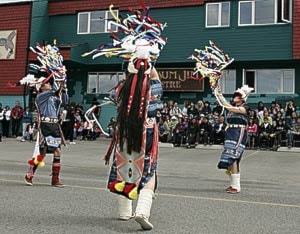Tyrell Jim and four of his friends spend hours after school practicing the songs and steps for traditional Native American dances.
Some of his peers don’t understand why.
It’s an uncommon hobby. And that makes it easy for others his age to quickly judge the Navajo youth group, said Jim after a performance in Whitehorse on Wednesday.
“We have very limited participation in our culture,” said Jim. “They don’t see it as a cool thing.”
The T’iis Nideeshgiizh Bitsooke Dancers (“maternal grandchildren of Newcomb”) are a group of five Navajo teenagers from Newcomb, New Mexico, singing and dancing their way across North America.
Their tour includes an upcoming show at the Midnight Sun Pow-wow in Fairbanks, Alaska.
About 400 people watched the Navajo teens as the danced on the street in front of the Skookum Jim Friendship Centre Wednesday.
The centre partnered with the Council of Yukon First Nations and the department of Education to bring the dancers to Whitehorse.
“We’re very excited to see this many people out here,” said Jim, who sings while the other four teens dance. “We’re trying to excite the audience and show them something they haven’t seen before.”
The dancers, just slightly older than the 10- to 14-year-olds frequenting the centre, offer a glimpse of what Whitehorse kids could be doing to keep busy, said Chris Nash, Skookum Jim’s sports and recreation co-ordinator.
“I’d be great for the kids in our summer day camp to take in some First Nations culture,” said Nash. “It’s something these kids don’t normally get to see.”
Rebecca Nielsen brought a dozen three-to-five-year-olds from a local daycare to the performance.
“It could show the kids how other cultures express themselves; they want to see the dancers,” she said before the performance.
The 300,000-person-strong Navajo nation, whose 70,000-square-kilometre territory crosses into Utah, Arizona and New Mexico, is one of the largest tribes in North America.
Originating in a Navajo language and history class taught by the group’s sponsor, Barbra Howard, the dance troupe consists of five close friends who’ve fallen into the part of role models for aboriginal youths wherever they perform.
“We’re good students,” said Jim. “The dancing helps us stay away from the bad stuff out there. We don’t drink, we don’t do drugs.”
“We’re continuing our education; we’re students trying to keep our culture alive,” said dancer Cordell Smith, 17.
“Back in New Mexico, our language is dying and we’re trying to get the message out to the youth that language and culture is important.”
Smith, a fluent Navajo language speaker, was invited to Howard’s language and history class to assist other teens just learning the language.
He has danced for two years.
“The dancing is very spiritual, and it gives me something to do more than anything,” said Smith with a grin.
“There’s nothing in my mind when I dance. I’m at ease. Like all the dancers, it seems like the dance moves just come naturally.”
The troupe learned the songs and dances from a professional group in Albuquerque, New Mexico, whose lead singer leant some of his material to the young dancers.
They incorporate both Navajo and non-Navajo traditional dances and songs into their routine.
“We like to perform from other tribes and then we’ll learn from them and they’ll take something from us,” said Jim, one of the four original dancers.
Before joining the group, he didn’t even know he had the vocals chops to sing the songs that accompany the traditional dances.
“The singing comes naturally,” he said. “I didn’t know I could sing like that. I didn’t know I could sing these songs.”
The other dancers include Christina Smith, 16, and Darielle Benally, 17, and Tiffany Segina, 16.
The extensive travelling hasn’t always been easy for the dancers, who would otherwise be spending their summers with friends and family back home.
“Going on the long trips, I miss my family back home,” said Smith. “But we have fun and try to make the best of it. This is our first time up here and probably our last.
“But the people here in Whitehorse have been really nice. Ahe’hee.”
That’s Navajo for “thank you.”
